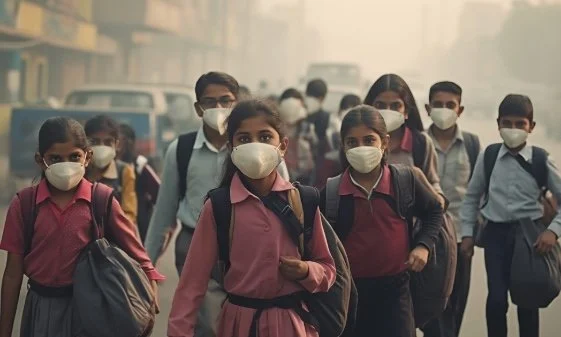Supreme Court Warns Against Physical Hearings as Delhi Air Turns Toxic
As Pollution Returns, the Question Is, Can the Government Be Blamed?
November 13, 2025
During a hearing unrelated to pollution in Delhi, a Supreme Court judge urged lawyers to avoid attending court in person, warning that the air was so toxic that “even masks are not enough.” The observation came as air quality in Delhi-NCR entered the “severe” category yet again, and at a time when the government is already under scrutiny in a separate case concerning its failure to control pollution.
A two-judge bench headed by Justice P. S. Narasimha asked lawyers why they were present in the courtroom despite the availability of virtual hearing facilities, as reported by The New Indian Express. Senior advocate Kapil Sibal informed the court that lawyers had been using masks inside the courtroom. Justice Narasimha responded by saying that he would speak to the Chief Justice.
Days earlier, on Nov. 10, dozens of protesters gathered at India Gate in New Delhi to demand urgent government action on the city’s worsening air quality. The crowd included children, elderly people and environmental campaigners, some carrying placards reading “Breathing is killing us” and chanting “Our right, clear air.” Police had warned against the protest, citing the area’s status as a non-designated site, as reported by Reuters. Officers detained several participants for “obstructing traffic” and registered a case under multiple legal provisions. Videos from the protest showed officers pushing and dragging some of the demonstrators.
India’s legal framework defines the duty of governments to prevent environmental hazards.
Under Article 21 of the Constitution, the right to life has been interpreted by courts to include the right to clean air. Both the Environment Protection Act, 1986, and the Air (Prevention and Control of Pollution) Act, 1981, empower authorities to act swiftly against sources of pollution, including construction dust, industrial emissions and vehicular exhaust.
However, year after year, the Air Quality Index (AQI) in Delhi reaches “severe” levels during winter, thanks to delayed response to stubble burning, lax enforcement of construction controls and lack of investment in public transport alternatives.
The government’s responsibility includes both preventive and emergency action, but most efforts are limited to the latter. Public health warnings, school closures and virtual court advisories, such as those now being suggested, are tools of crisis management, not governance. Preventive measures involve setting time-bound targets under the National Clean Air Programme, coordinating with state governments to address cross-border pollution, and promptly imposing penalties or curbs when air quality thresholds are breached.
Prolonged exposure to Delhi’s air causes long-term respiratory, cardiac and neurological damage. Vulnerable groups including children, the elderly and outdoor workers are at constant risk. For a city with multiple state and central agencies operating simultaneously, such conditions reflect gross administrative incoherence.
Many other countries have dealt with similar challenges through a combination of transparency, enforceability and long-term investment.
For example, in China, the government responded to dangerously high pollution levels in Beijing by shutting down heavy industries in and around the city, relocating power plants, banning high-emission vehicles and investing heavily in public transport and urban greenery. Crucially, air quality data is publicly available, and real-time alerts trigger automatic restrictions, not delayed discussions.
In the United Kingdom, the Ultra Low Emission Zone (ULEZ) in London requires drivers of high-emission vehicles to pay a daily charge to enter certain areas, leading many to switch to cleaner alternatives. This has significantly reduced air pollution in central parts of the city. Alongside this, a separate congestion charge discourages the use of private cars during peak hours, helping to limit traffic volume and cut emissions.
However, India’s response continues to rely on blaming individual sources in isolation, like stubble burning in Punjab, firecrackers in Delhi or construction in Noida, without integrating them into a coordinated mitigation strategy. Seasonal measures such as the Graded Response Action Plan are supposed to trigger strict pollution controls, but their application has apparently been inconsistent. The responsibility to activate and monitor these measures rests directly with governments at all levels, and failures to act constitute neglect of both legal duties and public health.
You have just read a News Briefing by Newsreel Asia, written to cut through the noise and present a single story for the day that matters to you. Certain briefings, based on media reports, seek to keep readers informed about events across India, others offer a perspective rooted in humanitarian concerns and some provide our own exclusive reporting. We encourage you to read the News Briefing each day. Our objective is to help you become not just an informed citizen, but an engaged and responsible one.

